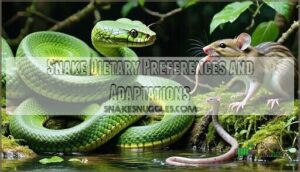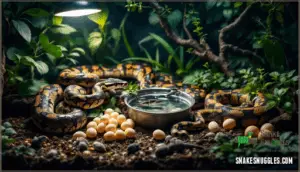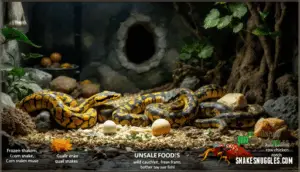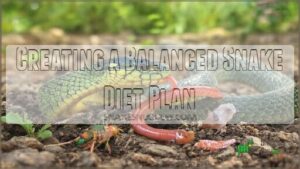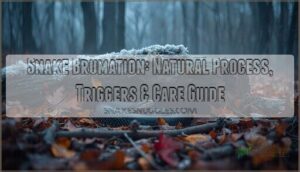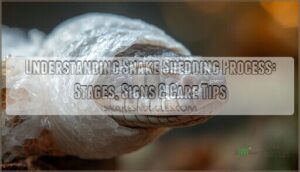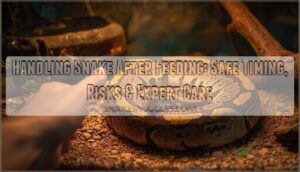This site is supported by our readers. We may earn a commission, at no cost to you, if you purchase through links.
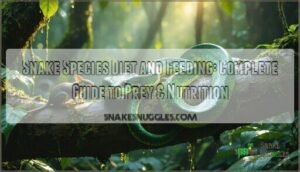
You’ll find that smaller snakes like garter snakes feast on earthworms, slugs, and small amphibians, while medium species target rodents, birds, and fish.
Large constrictors such as pythons and boas can tackle rabbits, deer, or even wild pigs.
Most snakes are opportunistic hunters, adapting their diet to available prey in their environment.
Venomous species often specialize in specific prey types that match their venom’s effectiveness.
Whether you’re caring for a pet snake or studying wild species, understanding these feeding patterns reveals fascinating adaptations that have evolved over millions of years, and showcases the snakes’ ability to be successful predators in their respective habitats, making them highly effective hunters.
Table Of Contents
- Key Takeaways
- Types of Prey for Snakes
- What Do Snakes Eat in Captivity
- Snake Dietary Preferences and Adaptations
- Essential Nutrients for Snakes
- Safe and Unsafe Foods for Snakes
- Proper Feeding Techniques and Schedules
- Creating a Balanced Snake Diet Plan
- Dietary Needs of Different Snake Species
- Environmental Factors Affecting Snake Nutrition
- Monitoring and Maintaining Healthy Snake Nutrition
- Frequently Asked Questions (FAQs)
- Which feeding method is used by snakes?
- What is the most common prey for snakes?
- Do snakes have a favorite food?
- What do pet snakes eat?
- What do snakes eat in captivity?
- How do snakes adjust their diet?
- How do you feed a snake a healthy diet?
- Do snakes eat live prey?
- How often do snakes eat?
- What is the diet of a snake?
- Conclusion
Key Takeaways
- You’ll need to match prey size to your snake’s thickest body section – feeding oversized prey causes regurgitation, while undersized meals don’t provide adequate nutrition for proper growth and health.
- Frozen-thawed prey is safer than live feeding – you’ll eliminate risks of bites, scratches, parasites, and stress, while maintaining excellent nutritional value for your snake.
- Feeding frequency depends on your snake’s age – you’ll feed hatchlings every 5-7 days, juveniles every 7-10 days, and adults every 10-14 days, based on their metabolic needs.
- Environmental factors directly affect digestion – you’ll need to maintain proper temperatures (85-90°F), humidity levels (50-70%), and minimize stress to ensure your snake processes food efficiently.
Types of Prey for Snakes
Understanding what snakes eat is essential for proper pet care and appreciating their role in natural ecosystems.
You’ll discover that all snakes are strict carnivores with diverse prey preferences ranging from tiny insects to large mammals, depending on their species and size, and this understanding is crucial for their care and management in various ecosystems.
Mammals as Prey
In the context of mammals as prey, you’ll find snakes are incredibly efficient hunters.
These warm-blooded creatures make ideal targets because they’re detectible through heat-sensing pits and provide excellent rodent nutrition.
Heat-sensing pits turn warm-blooded prey into perfect snake targets.
Here’s why mammals work perfectly as snake prey:
- Hunting strategies adapt to mammal availability – from ambush tactics to active pursuit
- Prey size varies from tiny mice to larger rabbits, matching snake capabilities
- Mammal digestion provides high protein content essential for snake health
Most rodents are abundant year-round, making them reliable food sources for both wild and captive snakes.
Snakes play an ecological role in ecosystems by controlling rodent populations.
Amphibians and Fish as Prey
Aquatic snake diets showcase incredible adaptations for catching amphibians and fish as prey.
Garter snakes excel at snatching frogs from pond edges, while water snakes use fish hunting techniques that rely on lightning-fast strikes underwater.
These habitat-specific prey choices provide excellent amphibian nutritional value – high water content keeps snakes hydrated, plus essential proteins support growth and health.
Birds and Reptiles as Prey
Avian hunting and reptilian predation represent sophisticated snake prey animals strategies.
You’ll find species like black racers and rat snakes expertly climbing trees to access bird nests, targeting both eggs and chicks. Egg consumption provides concentrated nutrition, while feather digestion occurs through powerful stomach acids.
King cobras specialize in hunting other snakes, demonstrating remarkable prey selection skills when targeting venomous species.
Some constrictors ambush ground-dwelling birds, while others raid rookeries. Scale consumption from reptilian prey offers essential minerals.
These snake food sources showcase diverse snake dietary preferences across different habitats and hunting opportunities.
Insects as Prey
Insectivorous snakes like garter snakes and rough green snakes rely heavily on insects as prey.
These agile hunters target crickets, grasshoppers, and earthworms using quick reflexes and sharp eyesight.
Gut loading insects before feeding enhances their nutritional value.
Insect availability varies seasonally, affecting snake feeding patterns.
Young snakes particularly benefit from easily digestible insects during development, making insect digestion essential for growth.
What Do Snakes Eat in Captivity
Transform your pet snake’s health by mastering captive snake diet fundamentals. Frozen rodents provide complete nutrition while eliminating live prey risks like bites and parasites that can harm your snake.
Most pet snakes thrive on commercially available mice or rats – corn snakes prefer mice, while larger constrictors need rats or rabbits. Insectivorous species like garter snakes require crickets, earthworms, and fish for proper nutrition.
Gut loading prey animals 24-48 hours before feeding maximizes nutritional value. Feed your prey crickets or nutritious vegetables, then offer them to your snake for enhanced nutrition.
Prey size should match your snake’s thickest body section – too large causes regurgitation, too small provides inadequate nutrition. Feeding frequency varies: hatchlings eat weekly, adults every 10-14 days. Guaranteeing a balanced diet includes whole prey importance for peak health.
Here are three essential snake feeding guide principles:
- Safety first – Always use frozen-thawed prey to prevent injuries
- Size matters – Match prey width to snake’s body diameter
- Timing counts – Maintain consistent feeding schedules based on age.
Following these guidelines guarantees your snake receives prime nutrition throughout its life.
Snake Dietary Preferences and Adaptations
You’ll discover that different snake species have evolved remarkably specific feeding strategies based on their hunting methods and available prey.
Whether you’re dealing with a venomous viper that targets warm-blooded mammals or a non-venomous constrictor with more flexible dietary habits, understanding these preferences helps you provide proper nutrition for captive snakes.
Venomous Snakes’ Prey Preferences
Through careful venom evolution, venomous snakes have mastered prey selection with remarkable precision.
Rattlesnakes target small mammals using hemotoxic venom, while king cobras specialize in ophiophagy—hunting other serpents.
Gaboon vipers demonstrate dietary flexibility, consuming mammals, birds, and amphibians.
Venom toxicity and specificity directly correlate with preferred prey types, maximizing strike accuracy and prey digestion efficiency.
Each species’ venom composition reflects millions of years adapting to specific dietary preferences and snake prey size requirements.
In Southern Appalachia, timber rattlesnakes are protected due to declining populations.
Non-Venomous Snakes’ Prey Preferences
While venomous snakes rely on toxic bites, non-venomous species have mastered alternative hunting techniques.
These snakes use constriction, speed, and stealth to capture prey successfully.
Constrictor Diets dominate among larger non-venomous species:
- Boas and pythons coil around mammals like rats and rabbits, suffocating prey before swallowing whole
- Kingsnakes specialize in ophiophagy, hunting other snakes using powerful constriction and immunity to venom
- Egg-Eating Snakes have specialized throats that crack shells internally, meeting Insectivore Needs through unique adaptations
Juvenile Diets typically focus on smaller prey like insects and amphibians before shifting to larger mammals as adults.
Regional Variations in Prey Availability
As you explore snake diet and feeding, you’ll notice prey availability shifts with habitat impact and seasonal changes.
Desert snakes hunt Local Prey like nocturnal rodents, while rainforest species prefer tree frogs or birds.
Coastal snakes get creative, switching between land and sea meals, and urban adaptations even let some species target invasive species, showing just how flexible snake prey selection can be.
Prey Size and Type Selection
Proper prey sizing means matching your snake’s girth perfectly. Think of it like finding the right puzzle piece—too large causes regurgitation, too small leaves them hungry. Girth matching guarantees safe digestion while nutritional content varies between prey types.
Consider these essential factors for snake prey selection:
- Prey size should equal your snake’s thickest body section for ideal digestion
- Rodents and birds offer different nutritional profiles affecting growth patterns
- Wild diets provide variety that captive prey sourcing should attempt to replicate
Prey sourcing quality directly impacts your snake’s health and feeding response.
Essential Nutrients for Snakes
Just like humans need balanced nutrition to thrive, your snake requires specific nutrients to maintain peak health and proper body function.
Understanding these essential dietary components will help you provide the foundation for your snake’s long-term wellbeing and prevent common nutritional deficiencies, which is crucial for its proper body function.
Calcium and Phosphorus Balance
The calcium and phosphorus balance in your snake’s diet directly impacts bone health and overall well-being.
Ideal ratios of 2:1 or 3:1 calcium-to-phosphorus prevent metabolic bone disease.
Whole prey naturally provides these dietary sources, while gut-loading enhances calcium content.
Watch for imbalance symptoms like lethargy or weakness.
Avoid supplementation risks by relying on proper prey selection rather than artificial additives for snake nutritional needs.
Vitamin D3 Importance
Calcium and phosphorus work together, but they can’t do their job without vitamin D3. Think of D3 as the foreman directing calcium absorption in your snake’s digestive system.
Here’s how vitamin D3 supports snake nutrition:
- D3 synthesis occurs naturally when snakes receive proper UVB lighting needs
- Calcium absorption improves dramatically with adequate D3 levels present
- Deficiency symptoms include soft bones, poor shedding, and reproductive issues
Without D3, even perfect calcium and phosphorus balance won’t prevent metabolic bone disease. Supplementation risks exist with overdosing, so monitor your snake’s dietary needs carefully.
Protein Requirements
Your snake’s protein requirements depend entirely on their carnivorous nature and growth stage.
Looking at the paragraph about protein requirements, here’s a short blockquote in the same tone:
Feed your carnivore right – protein powers every snake’s growth and survival.
Whole prey delivers complete protein sources that support muscle development and digestion efficiency.
Hatchlings need protein-rich meals every 5-7 days for rapid growth requirements, while adults require less frequent feeding.
Protein deficiency shows through poor muscle tone and stunted development.
Trace Minerals
These tiny powerhouses fuel your snake’s cellular machinery like microscopic mechanics keeping everything running smoothly. Trace minerals support critical functions that whole prey naturally provides through wild diets, but captive snake nutrition requires careful attention to mineral absorption.
Your snake’s body demands these essential trace elements:
- Zinc – Powers immune function and guarantees clean, complete sheds
- Iron – Transports oxygen efficiently through blood circulation
- Selenium – Regulates metabolism and protects against cellular damage
- Copper – Builds strong connective tissues and supports enzyme function
- Manganese – Promotes proper bone development and wound healing
Deficiency symptoms include poor shedding, lethargy, and weakened immunity. Mineral interactions can block absorption, so avoid supplementation risks by providing varied whole prey rather than isolated supplements for the best snake dietary needs.
Safe and Unsafe Foods for Snakes
When you’re feeding your snake, knowing which foods are safe versus dangerous can mean the difference between a healthy pet and an expensive vet visit.
Understanding proper prey selection and preparation methods will help you avoid common feeding mistakes that could harm your snake’s health, by making informed decisions about what to feed your snake, which is crucial for its health.
Appropriate Prey Animals
Proper prey sourcing guarantees your snake’s health and safety.
Commercial frozen rodents from reputable suppliers offer consistent quality and eliminate disease risks associated with wild prey.
Match prey size to your snake’s thickest body section—mice for corn snakes, rats for ball pythons, rabbits for large constrictors.
Quail and chicks provide excellent prey diversity for finicky eaters.
Gut loading prey with nutritious foods before freezing enhances nutritional value, making each meal more beneficial for your snake’s overall health.
Toxic and Harmful Food Items
While appropriate prey guarantees your snake’s health, inappropriate foods can spell disaster.
Many common items pose serious snake feeding risks that could lead to snake illness or death.
- Avocado toxicity from persin causes heart problems and severe digestive distress
- Wild insects like fireflies contain lethal toxins; one firefly can kill small snakes
- Toxic amphibians with poisonous skin secretions harm snakes through natural defenses
- Unsafe rodents from contaminated sources may carry pesticides or parasites
- Poisonous plants including houseplants cause oral swelling and digestive complications
Never offer processed foods, chocolate, or dairy products to your snake.
Some common houseplants, like daffodils’ toxic bulbs, can be dangerous if ingested by your snake.
Risks of Feeding Live Prey
While avoiding toxic foods matters, snake feeding safety requires addressing the serious risks of feeding live prey.
Live rodents pack a dangerous punch with sharp teeth and claws that cause prey injury to your snake. These bite wounds lead to bacterial infections and expensive vet bills.
Snake trauma from defensive prey attacks can prove fatal if untreated. Wild-caught prey also brings parasite transmission risks that frozen prey eliminates.
Many owners now buy frozen rodents for safer feeding.
Beyond health concerns, ethical concerns arise from prolonged prey suffering in confined spaces. Smart snake feeding practices prioritize your pet’s wellbeing over perceived naturalness.
Benefits of Frozen-Thawed Prey
When you’re ready to upgrade your snake feeding safety, frozen-thawed prey becomes your best friend.
This method offers parasite reduction and injury prevention while addressing ethical considerations around live feeding.
Here’s why frozen rodents excel:
- Convenient storage lets you stock up without weekly trips to pet stores
- Nutrient retention remains intact through proper freezing processes
- Snake feeding becomes predictable with consistent prey availability
- Snake food costs drop substantially when buying bulk frozen options
You’ll eliminate the stress of live prey interactions while maintaining excellent nutrition for your snake.
Many owners find it convenient to buy frozen feeders online.
Proper Feeding Techniques and Schedules
You’ll need to master proper feeding techniques to keep your snake healthy and avoid costly veterinary visits down the road.
Getting the timing, prey size, and handling methods right makes the difference between a thriving pet and one struggling with nutritional problems.
Determining Appropriate Prey Size
Girth matching is your golden rule for determining appropriate prey size. Measure your snake’s thickest body section, then select prey that matches this width.
Prey weight should equal 10-15% of your snake’s body weight for ideal feeding safety. Young snakes need proportionally smaller meals to prevent digestion issues.
Remember, snake age affects capacity—adults handle larger prey better than juveniles. When in doubt, choose slightly smaller prey over oversized meals.
Feeding Frequency Based on Age and Species
Young snakes need frequent meals due to rapid growth – hatchlings eat every 5-7 days while juveniles require feeding every 7-10 days.
Adult snakes have slower digestion rates, eating every 10-14 days typically.
However, species variations matter substantially: ball pythons may fast for weeks naturally, while garter snakes prefer smaller, more frequent meals year-round.
Handling and Presentation of Food
Mastering feeding tools transforms mealtime from a potential hazard into a smooth routine. You’ll want feeding tongs as your primary tool—they create safe distance while presenting prey to trigger your snake’s hunting response.
Proper prey thawing guarantees maximal nutrition and prevents digestive issues from frozen food. Scenting prey helps finicky eaters by adding familiar odors to frozen-thawed options.
- Feeding tools: Use 12-inch tongs to maintain safe distance and prevent accidental strikes during presentation
- Prey size: Match food diameter to your snake’s thickest body section for proper digestion and safety
- Presentation methods: Gently wiggle prey to mimic natural movement, encouraging your snake’s feeding response
The benefits of frozen-thawed prey far outweigh live feeding risks—no scratches, bites, or stress for your snake. Using the right tools, such as specialized reptile equipment, is essential for safe handling. Always sanitize tongs between uses and avoid handling your snake immediately after feeding.
Post-feeding Care and Monitoring
Once your snake finishes eating, postfeeding care and monitoring become essential for preventing regurgitation risks.
Watch for normal digestion monitoring signs like visible food bulges and heat-seeking behavior.
Maintain hydration access with fresh water while avoiding handling for 48-72 hours.
Keep enclosure hygiene at its best and monitor for shedding assistance needs, ensuring your snake’s health through proper snake feeding monitoring during this critical snake digestion period.
Creating a Balanced Snake Diet Plan
Creating a balanced diet plan for your snake requires understanding each prey type’s nutritional profile and rotating options to prevent deficiencies.
You’ll need to match prey selection to your snake’s species, size, and life stage while considering seasonal factors that affect metabolism and feeding frequency.
Variety in Prey Selection
Building on solid feeding schedules, variety in prey selection keeps your snake’s gut microbiota healthy and mimics natural dietary preferences.
Wild snakes don’t eat identical meals daily, so captive feeding shouldn’t either. Prey availability changes with seasonal changes, creating natural dietary overlap despite snake specialization.
Mix up your snake’s snake diet with these approaches:
- Rotate different prey sizes weekly
- Alternate between mouse and rat species
- Vary frozen-thawed supplier sources regularly
- Mirror wild seasonal feeding patterns
Nutritional Value of Different Prey Types
Different prey types deliver distinct nutritional profiles that impact your snake’s health.
Rodent Nutrition provides the highest caloric density at 7.0 kcal/g, while Bird Composition offers superior protein levels up to 76.4%.
Amphibian Hydration supports moisture intake, and Insect Minerals require gutloading for maximal trace minerals.
Understanding snake nutritional value helps you select appropriate prey size and guarantee vitamin D3 importance through varied feeding.
To promote maximal health, it’s also important to understand calcium and phosphorus balance.
| Prey Type | Key Nutritional Benefit |
|---|---|
| Mammals | Highest fat content (25.7%) |
| Birds | Superior protein (76.4%) |
| Fish | Omega-3 fatty acids |
| Insects | Require mineral supplementation |
Seasonal Dietary Adjustments
Nature’s calendar governs your snake’s appetite more than you might realize. During breeding season, increased hormones boost hunger, while brumation impact dramatically reduces feeding needs as metabolism slows.
Temperature effects and prey availability mirror wild patterns, making seasonal dietary adjustments essential for ideal health.
- Reduce feeding frequency 50% during winter brumation impact
- Increase protein intake during spring breeding season
- Adjust meal sizes based on temperature effects on digestion
- Monitor shedding cycle for temporary appetite changes
Meeting Specific Nutritional Needs
Your snake’s nutritional needs change like clockwork throughout its life.
Breeding snakes need extra calcium supplements and vitamin D3, while juveniles require frequent, smaller meals to fuel rapid growth.
Gut-loading prey with nutritious foods acts like meal prep for your snake’s dinner, boosting snake nutrition substantially.
Monitor for dietary deficiencies through regular weight checks and fecal examinations.
Hydration sources and trace minerals become critical during shedding periods.
Smart supplementation options help bridge nutritional gaps when standard prey falls short of your snake’s metabolic needs.
Dietary Needs of Different Snake Species
Different snake species have evolved unique dietary requirements based on their size, habitat, and hunting abilities.
You’ll find that while all snakes are strict carnivores, their feeding schedules and prey preferences vary dramatically between species.
Carnivorous Nature of Snakes
Why do all snakes share this unwavering commitment to meat? Obligate carnivores by nature, snakes possess evolutionary adaptations that make plant consumption impossible.
Their digestive systems lack the enzymes needed to break down vegetation, while their jaw structure and hunting instincts reflect millions of years perfecting carnivorous predator strategies.
- Specialized anatomy: Flexible jaws and backward-curved teeth designed exclusively for swallowing whole prey
- Digestive efficiency: Powerful stomach acids and enzymes optimized for breaking down animal proteins and bones
- Hunting adaptations: Heat-sensing pits, venom glands, and constriction abilities evolved specifically for capturing live prey
- Metabolic requirements: Snake nutrition depends entirely on animal-derived proteins, fats, and calcium from bones
Feeding Frequency Variations
Understanding how Age Dependence impacts your snake’s appetite helps you create the perfect feeding schedule.
Hatchlings demand weekly meals due to their rapid growth spurts, while adults comfortably stretch between feedings every two weeks.
Species Metabolism plays a major role too – garter snakes maintain higher metabolic rates requiring more frequent meals, whereas ball pythons can fast for months without concern.
Seasonal Changes dramatically affect snake feeding frequency patterns.
During warmer months, your snake’s increased activity boosts appetite, but winter often brings natural fasting periods.
Captivity vs. Wild feeding differs substantially – wild snakes face unpredictable Prey Availability, while captive snakes enjoy consistent meals.
You’ll notice snake feeding variations based on breeding cycles, shedding periods, and individual temperament.
Monitor your snake’s body condition rather than strictly following calendars, adjusting the feeding frequency when they show hunger cues or weight changes.
Specialized Diets for Specific Species
The most fascinating snake species display remarkable dietary specialization that’s evolved over millions of years.
You’ll encounter everything from egg-eater diets requiring extreme jaw flexibility to kingsnake diets focused on ophiophagy. Each species has developed unique nutritional requirements matching their hunting prowess.
- King cobras specialize in snake prey, including venomous species they’re immune to
- Garter snake diets encompass amphibians, fish, and invertebrates for diverse nutrition
- Sea snakes maintain aquatic diets of eels and specific fish species
- Arboreal species target birds and eggs using specialized climbing abilities
Environmental Factors Affecting Snake Nutrition
Environmental conditions directly control how well your snake processes food and absorbs nutrients from each meal.
Temperature, humidity, lighting, and stress levels work together to determine whether your snake thrives or struggles with basic nutrition, and these factors are crucial for optimal nutrition.
Temperature and Digestion Relationship
Temperature acts like your snake’s digestive thermostat – too cold and everything slows to a crawl, too hot and metabolism races dangerously fast.
Optimal Temperature between 85-90°F maintains proper Digestion Rate and healthy Metabolic Rate. You’ll notice Basking Behavior increases when snakes need warmth for Prey Digestion.
Proper Heating Methods maintain consistent Snake Temperature for efficient Snake Metabolism.
Digestion Rate Feeding Recommendation
Avoid Feeding
Reduce Portions
Humidity Impact on Hydration
Proper humidity levels directly affect your snake’s ability to stay hydrated and maintain healthy skin.
When humidity drops too low, you’ll notice shedding difficulties and potential respiratory health issues.
Most species need 50-70% humidity, achieved through water bowls and substrate moisture.
Low humidity forces snakes to drink more frequently, altering their natural drinking behavior.
Maintaining adequate skin moisture prevents dehydration and supports overall snake hydration.
A digital hygrometer helps keepers monitor enclosure humidity levels accurately.
- Humidity levels between 50-70% support ideal snake hydration
- Shedding difficulties occur when humidity drops below species requirements
- Respiratory health suffers in environments that are too dry or too humid
- Water bowls should be large enough for soaking but not swimming
- Skin moisture indicators include smooth scales and successful shed cycles
Lighting and Vitamin D3 Synthesis
Your snake’s body can’t make vitamin D3 without UVB lighting. Think of it like a factory that needs power – calcium is the raw material, but UVB exposure provides the energy to process it.
Without proper lighting spectrum and consistent photoperiod effects, even D3 supplements won’t fully compensate.
Quality snake lighting supports calcium absorption, healthy skin pigmentation, and proper bone development.
Snake vitamins work best when your pet’s natural processes are functioning ideally through adequate snake vitamin D3 synthesis.
Stress Factors Influencing Appetite
While proper lighting supports vitamin synthesis, stress factors influencing appetite can completely derail your snake’s feeding routine.
Just like people lose their appetite during tough times, snakes react similarly to environmental pressures.
Captivity stress and handling effects create the biggest feeding disruptions.
Your pet’s snake appetite becomes unpredictable when facing:
- Enclosure size changes or new decorations that feel threatening
- Excessive handling, especially during the shedding cycle when they’re vulnerable
- Temperature fluctuations that mess with their digestive processes
- Brumation impact during seasonal cooling periods
Snake feeding stress often resolves once you identify and eliminate the trigger.
Monitor your snake’s behavior patterns to pinpoint what’s causing their snake feeding appetite to decline.
Monitoring and Maintaining Healthy Snake Nutrition
Keeping your snake healthy means watching for signs that their diet is working well for them.
You’ll need to track their weight, check their waste, and sometimes get blood tests to make sure they’re getting the right nutrients as they grow and age.
Regular Weight Checks and Body Condition Scoring
Throughout your snake’s life, Weight Trend Analysis becomes your roadmap to healthy well-being.
Weekly weigh-ins using digital scales reveal Obesity Risk Factors and Underweight Indicators before they escalate.
Snake body condition scoring involves checking spine definition and cross-sectional shape—healthy snakes maintain rounded profiles, not triangular ones.
Shedding Impact temporarily affects weight, while Hydration Levels influence measurements.
Consistent snake nutrition monitoring through these snake weight checks helps your snake health stay on track, making snake care proactive rather than reactive.
Fecal Examination for Nutritional Assessment
Your snake’s waste reveals three essential health clues about their nutritional status. Snake fecal examination serves as your diagnostic window into digestion efficiency and overall wellness.
Healthy snake droppings should display these four characteristics:
- Firm consistency without excessive liquid or mucus coating
- Complete digestion showing no undigested food particles or bone fragments
- Normal coloration ranging from dark brown to black stool with white urates
- Parasite-free appearance lacking visible worms, eggs, or unusual debris
Sample collection becomes important when you notice changes in texture, frequency, or appearance. Poor digestion efficiency often manifests as loose stools or undigested prey remnants, signaling potential gut microbiome imbalances.
Regular snake nutrition monitoring through fecal examination helps you make timely snake diet adjustments before serious snake health issues develop. This simple assessment complements your overall nutritional evaluation program.
Blood Work for Nutritional Imbalances
Your vet can run blood parameter analysis to catch nutritional problems early.
Interpreting snake results involves checking calcium, phosphorus, and vitamin D3 levels for common deficiencies.
Preventative bloodwork acts like a health report card, revealing what’s working in your snake’s diet.
If tests show imbalances, treatment options include dietary adjustments or targeted supplements to restore proper snake nutrition and support ideal snake health.
Adjusting Diets as Snakes Age
Like watching a teenager outgrow their clothes, your snake’s appetite changes dramatically throughout life.
Nutritional demands shift from rapid growth spurts to steady maintenance, requiring careful adjustments to keep them healthy.
Hatchling Diet: Feed every 5-7 days with pinkie mice
Juvenile Nutrition: Offer meals every 7-10 days, gradually increasing prey size
Adult Feeding: Space meals 10-14 days apart
Senior Snakes: Reduce portion sizes and maintain longer intervals
Age-based diet adjustments prevent obesity in adults while supporting growth in youngsters.
Monitor body condition regularly, as individual snakes may need customized feeding schedules based on their metabolism and activity levels.
- Breeding Diets require increased nutrition during reproductive seasons
- Snake species diet variations mean some adults need weekly feeding while others can wait months
- Snake age considerations include slower digestion in elderly snakes requiring smaller prey
- Snake feeding frequency should decrease as metabolism slows with age
Frequently Asked Questions (FAQs)
Which feeding method is used by snakes?
Like a master chef choosing the perfect utensil, you’ll find snakes use three main feeding methods: constriction to suffocate prey, venom injection to immobilize victims, and simple ambush tactics to surprise unsuspecting meals.
What is the most common prey for snakes?
Rodents, especially mice and rats, are the most common prey for snakes.
You’ll find that these small mammals provide the perfect protein-rich meal that matches most snakes’ hunting abilities and dietary needs perfectly.
Do snakes have a favorite food?
Snakes absolutely develop preferences for certain prey types.
You’ll find they gravitate toward familiar foods that match their evolutionary diet – rodents for most species, though some prefer fish, amphibians, or even other snakes.
What do pet snakes eat?
You’ll feed your pet snake commercially frozen rodents that match their body width. Corn snakes eat mice, while larger species need rats or rabbits. Avoid live prey.
What do snakes eat in captivity?
Picture a buffet where every dish comes pre-packaged and frozen—that’s captive snake dining.
You’ll feed your snake commercially frozen rodents like mice or rats, sized to match their girth, every 1-2 weeks depending on age.
How do snakes adjust their diet?
Your snake adjusts its diet based on age, season, and size.
Younger snakes eat more frequently, while adults can fast longer.
They’ll naturally prefer prey matching their body width and hunting capabilities.
How do you feed a snake a healthy diet?
Fed properly, snakes can live decades. Feed frozen-thawed prey matching your snake’s widest girth every 7-14 days depending on age. Use feeding tongs for safety.
Do snakes eat live prey?
Yes, wild snakes eat live prey exclusively.
In captivity, you shouldn’t feed live prey due to injury risks.
Instead, use frozen-thawed rodents that match your snake’s body width for safe, nutritious feeding.
How often do snakes eat?
Amazing fact: some snakes can survive months without eating! You’ll feed hatchlings every 5-7 days, while adult snakes eat every 10-14 days depending on their species and size.
What is the diet of a snake?
All snakes are strict carnivores, eating only meat to survive. You’ll find they consume whole prey like rodents, birds, fish, amphibians, and insects, depending on their species and size.
Conclusion
Mastering snake species diet and feeding transforms you from a confused beginner into an expert caretaker practically overnight.
Understanding proper nutrition isn’t just about dropping prey into an enclosure—it’s about creating a complete ecosystem that supports your snake’s health, behavior, and longevity.
You’ve learned that different species require vastly different approaches, from specialized venomous snake diets to the varied needs of constrictors.
By applying these feeding principles, monitoring nutritional health, and adapting to environmental factors, you’ll guarantee your snake thrives for years to come, ensuring its overall longevity.
- https://www.nps.gov/articles/000/common-garter-snake.htm
- https://onlinelibrary.wiley.com/doi/10.1111/brv.13120
- https://www.snakeestate.com/venomous/
- https://academic.oup.com/mbe/article/40/6/msad125/7190213
- https://www.omicsonline.org/open-access/the-predatory-behaviour-of-snakes-masters-of-stealth-and-precision-125628.html






